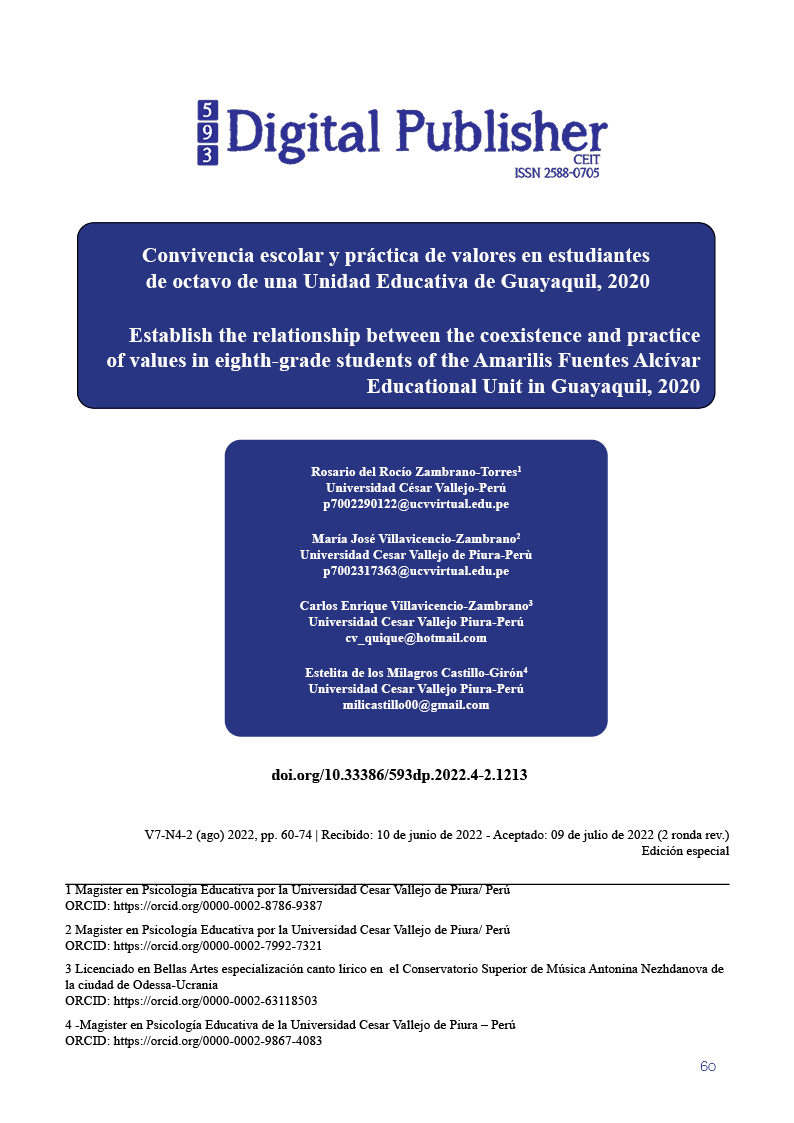Establish the relationship between the coexistence and practice of values in eighth-grade students of the Amarilis Fuentes Alcívar Educational Unit in Guayaquil, 2020
Main Article Content
Abstract
The objective of this research project was to establish the relationship between the coexistence and practice of values in eighth-grade students of the Amarilis Fuentes Alcívar Educational Unit in Guayaquil, 2020. The type of research applied according to its application was basic, due to the foundation and enrichment of scientific knowledge, due to its character, the study was correlational, by measuring the influence of one variable on the other. By nature, a quantitative process was applied to obtain statistical results, according to its cross-sectional scope based on evidence and the non-experimental design. According to the results obtained in the verification of the general objective in the Spearman correlation, a value of 0.890 ** was detected, which compared to the criteria of scales, showed a significant and very high correlation between the variables. On the other hand, in the evaluation of the significance level, 0.000 was obtained, which, being less than 0.05, rejected the H₀, checking the general hypothesis. In conclusion, in the descriptive statistics it was observed in table # 4 and figure # 1, that the majority value was for the average category with 41.8% (19), secondly to the good category with 36% (16) This shows that it exists at an average level of school coexistence. In table # 5 and figure # 2, check the result of the practical variable of values in which the highest value was obtained for the good category with 55.7% (25) and the average category with 20, 1 % (9). Proving that the practice of values occurs at a good level in the institution.
Downloads
Article Details

This work is licensed under a Creative Commons Attribution-NonCommercial-ShareAlike 4.0 International License.
1. Derechos de autor
Las obras que se publican en 593 Digital Publisher CEIT están sujetas a los siguientes términos:
1.1. 593 Digital Publisher CEIT, conserva los derechos patrimoniales (copyright) de las obras publicadas, favorece y permite la reutilización de las mismas bajo la licencia Licencia Creative Commons 4.0 de Reconocimiento-NoComercial-CompartirIgual 4.0, por lo cual se pueden copiar, usar, difundir, transmitir y exponer públicamente, siempre que:
1.1.a. Se cite la autoría y fuente original de su publicación (revista, editorial, URL).
1.1.b. No se usen para fines comerciales u onerosos.
1.1.c. Se mencione la existencia y especificaciones de esta licencia de uso.
References
Antúnez, S. (2006). Como educar en valores. Madrid, Narcea.
Arón, A. M., Milicic, N., Sánchez, M., & Subercaseaux, J. (2017). claves para la convivencia escolar. Construyendo juntos: 16-32.
Berkowitz, L. (1996). Agresión: causas, consecuencias y control. Libro.
Cheprasov, A. (2019). Los valores. Practica de valores, https://business.tutsplus.com/tutorials/what-are-personal-values--cms-31561.
Cherry, K. (2018). How Basic Research Is Used in Psychology. Investigación Básica, https://www.verywellmind.com/what-is-basic-research-2794876.
Coello, B. A. (2019). Aprendizaje cooperativo como estrategia para la convivencia escolar en el proceso de enseñanza y aprendizaje. Artículo científico - Ecuador - PUCESE - Maestría
Díaz, B. S., & Sime, P. (2016). Convivencia escolar: una revisión de estudios de la educación básica en Latinoamérica. Revista Virtual Universidad Católica del Norte, 49, 125-145, 45-90.
Díaz, B. S., & Sime, P. L. (2016). Convivencia escolar: una revisión de estudios de la educación básica en Latinoamérica. Artículo científico de la Revista Virtual Universidad Católica del Norte, núm. 49, p. 125-145.
Dictionary Biol. (2016). Biologydictionary.net Editors., 26.
Fernández, S. S., Vigi, M. Á., & Gómez, M. d. (2017). La evaluación de la convivencia escolar en contextos de diversidad cultural. Education and Humanities at Melilla, 33-58.
Fuentes, G. B., & Rodríguez-Garcés, C. R. (2019). Clima de convivencia escolar en Chile: un análisis desde el nuevo marco de medición de calidad educativa. Artículo científico de la Revista Educación, Vol. 43, N°. 2.
José Mauricio Sánchez Ortiz, J. D. (2018). Particularidades de la convivencia escolar. Artículo científico, Vol. 16; No. 02; p. 92 - 116.
Ministerio de Educación. (2019). Educación para la Democracia y el Buen Vivir. Acoso Escolar, https://educacion.gob.ec/acoso-escolar/.
Nietzsche. (1876). Transmutación De Los Valores. Filosofía contemporánea, Volumen 3: Editorial Edinumen.
Quicios, B. (2017). La importancia de las normas de convivencia en clase para los niños. Psicólogo educativo,
Trucco, D. (2017). Las violencias en el espacio escolar. Chile: UNICEF.
Trujillo, D. D. (2019). Convivencia escolar y valores en estudiantes de grado octavo y noveno de la institución educativa policarpa Salavarrieta del municipio de quimbaya (Quindío). Artículo Científico para tesis doctoral, Vol. 5; N°23; p. 56-79.
Unesco. (2018). Convivencia escolar para la ciudadanía a la luz de las dimensiones declaradas por la Unesco: percepción de los estudiantes de segundo ciclo. Unesco, Osorno Collage. Chile.
UNICEF. (2018). Violencia en las escuelas.
Us Soc, P. (2009). La Práctica de los valores en el aula / Pedro Us Soc. – 1a. Coordinación Educativa y Cultural Centroamericana, 61-2.





